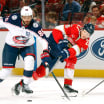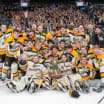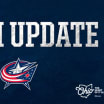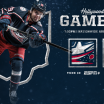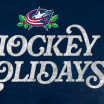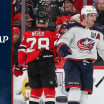Jared Berry has had two instances in his life where he can say he’s proud he came up with a name that will live on.
The most recent was with his daughter, Alice Eleanor Berry, who was born this March.
The first was with the Columbus Blue Jackets.
So, which one was harder to come up with?
“What a good question that is,” Berry said. “It was an eerily similar kind of experience because there were a lot of names being thrown at the wall and seeing what stuck. And just like with the team, I didn’t have full control; I was just an ideas person. But of course, naming my daughter, I actually got to be in the negotiations instead of just handing the ideas over.”
In the end, it’s fair to say Berry did just fine on both occasions. Alice Eleanor Berry has a bright future, while the Blue Jackets are now well into their third decade of existence.
In fact, exactly 25 years ago today, the Blue Jackets became the Blue Jackets. While the NHL awarded the franchise to Columbus and majority owner John H. McConnell in June of that year, ending the city’s years-long pursuit of a team it could call its own, the Blue Jackets nickname and a pair of logos debuted Nov. 11, 1997.
And Berry is one of a handful of people who can say he had a hand in the process. While the final decision was made by team officials in concert with the NHL -- and had to go through plenty of discussion and vetting -- there were seven fans who submitted the name as part of a marketing campaign that began when the team was announced.
Sponsored by Columbus-based hamburger outlet Wendy’s, the campaign resulted in around 14,000 entries. Seven of them, including one entered by Berry, suggested Blue Jackets.
Later, Berry was the winner of a contest to determine which of those fans would win the grand prize of season tickets, spurring a lifelong love of a team he still holds dear despite the fact he lives in Houston, Texas.
In other words, it took a community effort to come up with the name, even if the community was divided at first. Talk radio stations and newspapers like the Columbus Dispatch and The Other Paper debated back and forth as to whether the Jackets left them putting on their blue suede shoes or simply feeling blue.
But all these years later, it’s hard to imagine being anything else but the Columbus Blue Jackets.
“We had to sort of take our lumps until they got their head around it,” said Cathy Lyttle, an early director of the team’s business office who was involved in the name discussions. “But you know, 25 years later, I can’t imagine the team being called anything else.”
Creating A Name
Let’s start here -- it's not easy to name an expansion professional sports franchise.
Even some of the great nicknames that have stood the test of time would sound funny if you came up with them today. There was a time where it might make sense to name a football team in Green Bay after a packing company or a baseball team in Boston or Chicago by the color of its socks, but those days are long gone.
In the current era, a nickname has to encapsulate the vibe of a city, and it helps if it comes across as somewhat fierce or intimidating. At the same time, it can’t be too close to anything else already established in a league -- or anywhere else for that matter, considering trademark law. That whittles things down quite a bit before you even get to the matter of whether fans will even like it.
At the same time, who wouldn’t want to tackle that challenge? It’s the dream of so many sports fans to be given a blank canvas with the opportunity of letting their imaginations run wild.
“First, you need a name, then you need a logo, and hey, let’s get cracking on the jerseys while we’re at it.”
Lyttle, who was one of the team’s first front office staffers in 1997 as vice president of JMAC Hockey, LLC, confirms that while it was a challenge to come up with the Blue Jackets’ identity, it was also a heck of a lot of fun.
“Oh my gosh, it was a blast,” Lyttle said in a 2020 interview. “I have gotten to do some really neat things in my career, but having this experience for two years was clearly a highlight.
“But naming a team was kind of a big deal. It was hard.”
The group in charge included McConnell, Lyttle and John Christie, president of JMAC Hockey, the team’s management company. The NHL’s team -- led by creative services director David Haney, who helped the league launch a number of franchises during its expansion boom in the 1990s -- also had a big say given their experience.
Once the team was confirmed to be coming to Columbus in June, the kickoff of the naming campaign included the Wendy’s contest. Berry -- then a 19-year-old Columbus resident at home for the summer from Wright State University -- said he stopped by the Wendy’s location near Columbus State, where he was taking summer classes, nearly every day to drop off a new idea.
To Haney, the concept of including the fans for suggestions was a good one.
“Asking people for ideas for names I thought was a great idea because then you could see the ones that ownership would say, ‘Never,’ or, ‘That’s interesting,’” Haney said. “Then it was, what could you trademark, what could you protect? That sort of become the next thing.
“The Wendy’s contest was not a popularity contest. It was just, give us your best name. I think there were 13,000 entries and only seven said Blue Jackets. They were just looking for a name.”
On the team side, the league worked with McConnell and his group in Columbus to see what their preferences might be.
“They put Mr. McConnell through some exercises, which was kind of hilarious,” Lyttle said. “I remember very vividly sitting in a conference room with him, and this is when we were picking colors. He had gone through sort of a questionnaire that they had asked him about what his favorite colors were, and this and that and everything else. We were sitting in this room with the colors and some looks at the jersey, and they were plastered all over the wall.
“He finally looks at all of us and said, ‘I wasn’t very good at art. I don’t know if I can do this,’ which we all laughed at.”
Business, of course, was McConnell’s strongest point as the founder of Worthington Industries, but he did have a few preferences on how things would go. McConnell wanted blue to be one of the colors, and the hope was to include a patriotic or Midwestern theme given the team’s location and McConnell’s service in the U.S. Navy during World War II.
Making A Decision
In the end, the Blue Jackets chose 10 names from both their initial discussions and those submitted in the Wendy’s contest to the NHL for vetting.
Among those not chosen? Names that had been used by prior Columbus teams, including the Checkers, Golden Seals, Owls and Chill, even though the latter’s explosion in popularity helped pave the way to make Columbus an NHL city. In the end, the ownership wanted a new identity as it turned the page to hockey at the highest level.
And then there was the Columbus Mad Cows, which The Other Paper, a satirical weekly newspaper that had a devoted cult following in the city, suggested as a nod to Columbus “cowtown” roots. It proved so popular -- at least among the marketing team with the Chill -- that the ECHL team actually wore Mad Cows jerseys for Halloween in 1997.
“There was a big push for that,” Lyttle said. “Can you imagine, 25 years later? That would have been insane. But it was a good laugh, and I actually had a Mad Cows T-shirt for a long time.”
In the end, the list of name submissions -- 14,000 in all just through the Wendy’s contest -- was whittled down to two: Blue Jackets and Justice. This was an era in which the conceptual nickname was in, as the Magic and the Heat in the NBA were joined by the Lightning and the Avalanche in the NHL. Heck, the Blue Jackets’ expansion brethren in Minnesota are still the Wild.
But, as McConnell told the Dispatch at the time, “we just didn’t understand” Justice.
The Columbus NHL team would be known as the Blue Jackets.
The name was selected because it pays homage to Ohio’s contributions to American history and the great pride and patriotism exhibited by its citizens, especially during the Civil War as both the state of Ohio and the city of Columbus were significantly influential on the Union Army. Ohio contributed more of its population to the Union Army than any other state, while many of the blue coats worn by the Union soldiers were manufactured in Columbus.
The league didn’t just release a name on Nov. 11, 1997. There were also two logos -- first, a lime green bug in a Union Army coat and hat named Stinger, and secondly, a star-studded red ribbon unfurled to spell out the team’s initials, CB, with an electric green hockey stick cutting through the center to represent the “J.”
This was an era in which bold colors were in, and you couldn’t go very far without finding an expansion franchise that wasn’t wearing some version of teal, whether it was the Marlins in MLB, the Panthers and Jaguars in the NFL, or the Grizzlies in the NBA. Purple also was a popular choice for the baseball Rockies and Diamondbacks and basketball Raptors.
Simply put, going bold was the style at the time, and with printing presses catching up to fashion tastes and pop culture takes, you had to stand out to get noticed. While the Blue Jackets would be born with a base of blue and red Americana, the mold would be broken by the inclusion of lime green.
“It was madness,” Haney said. “At the time, sports licensed product fashion was just hot, hot, hot, hot, hot. It was a huge business, and so there was definitely a fashion orientation. That lime green was a color that was going to be in the fashion palate of that time.
“It wasn't a crazy kind of choice, and when you look at it, it just jumps off the field with the blue. It is so electric, it just pops like that. So it was very much understanding how popular sports licensed product was, and the more outrageous the better in a lot of ways.”
As for Stinger himself, the decision to go with a “bug with an attitude” to represent a team named for the Civil War was twofold. Again, remember the times -- bigger was better when it came to the characters the league was trying to sell. Plus, it was a play on words -- Stinger, after all, was simply a yellow jacket of a different color.
"We worked backward to find something that would bring the Columbus brand of NHL hockey to life," Haney said at the time. "It came down to some kind of terrific-looking bug that had all this ingenuity, was fast, industrious -- all these great attributes. There are yellow jackets, it's a near cousin to the famous yellow jacket."
Then … The Reaction
Once things were decided, the organization circled a November release of the name, which eventually happened on Nov. 11, 1997.
But by Nov. 6, word leaked out to local talk radio stations, and a story about the name was featured in the Nov. 7 edition of The Dispatch.
The reaction was divided. Jackie Hoover, a greeter at the Buckeye Hall of Fame Café, told the Dispatch she wasn’t a fan.
"Yuck," she said. "No way. What kind of name is that?”
Jeff Griss of Grove City, meanwhile, sang the opposite tune at the restaurant on Olentangy River Road.
"I like it," he told the newspaper. "It's different. Actually, I think we should be glad we have an NHL team, regardless of the name."
Perhaps the biggest opposition to the name came from those who simply couldn’t wrap their minds around an Ohio State-crazed city choosing blue not just for its colors but its name. After all, the rivals at the University of Michigan chant, “Go Blue!”
“One of the worst emails I got was from a guy, and I’ve never forgotten it,” Lyttle said. “It was basically like, ‘How could you? First of all, we are going to be laughed out of the NHL for this name, and with our affinity for Ohio State, how could you slap blue on it?’ It was just kind of stunning to me that someone could be that upset about it.
“But I think we’ve evolved as a community, I love Ohio State as much as the next person, but I think we’ve gotten a lot broader, wider and deeper here.”
In the end, the proof was in the pudding when it came to merchandise sales. According to the Dispatch, T-shirts, priced $17 to $28 at BK Sports at New Market Mall, sold out in half an hour once the name was officially debuted. By 9 p.m., JCPenney at Eastland Mall had sold most of its inventory of about 800 shirts.
Berry said he had first gotten the name Blue Jackets from a friend, Mike Leahy, who had read it in The Other Paper. It grew on him as time went by, and the big-time sports fan was excited to see professional athletics coming to his hometown, adding to his zeal as he stopped by Wendy’s each day to take part in the contest.
Little did he know he’d be one of those who could say he had a hand in naming the team -- even if he also gave Leahy some of the credit.
“I made sure he got taken care of,” said Berry, who has remained a season ticket holder since winning the grand prize for the inaugural season. “I remember him sending me an email the day they were announcing they were the Blue Jackets that said, ‘I called it! It’s the Blue Jackets!’ I wrote back and said, ‘Did you submit it as one of the names? Because I did.’
“But I admitted that while the idea resonated with me deeply, he gave me the idea, so of course I took him to the games.”
Finishing It Off
While the name was announced less than four months after Columbus was awarded an NHL franchise, a mascot and uniforms would have to wait a little longer.
As Lyttle got to work to help bring Stinger to life, she had the ultimate resource in her own home -- a sports-loving 8-year-old son named Jack.
“My favorite story was about the mascot,” she said. “That's not an easy thing either, so I had a focus group of one, and it was 8-year-old Jack Lyttle. I came home after a bunch of deliberations and the NHL had gotten back to us with a bunch of different things, and I had a color image of Stinger and I just said, 'Hey I want to show you something.' We sat at our kitchen table and I lifted it up, and his eyes lit up and I said, 'Do you like it?' He goes, 'I love it, what is it?' I told him what it was and I said, 'You can't tell anybody, it's a secret.'”
Initial ideas for Stinger included the potential for the mascot to descend from a hive constructed in the rafters of the arena, as well as an entourage of sidekicks known as “The Drones.” The original plan also included a theme song for Stinger based on Nikolai Rimsky-Korsakov's operatic classic “Flight of the Bumblebee” with a little heavy metal thrown in.
While none of those concepts quite saw the light of day, the original Stinger mascot was introduced at Columbus’ annual Red, White & Boom Fourth of July parade in 1999. Five months later, the jerseys were next to make their debut when they were introduced in front of more than 4,000 fans at Easton Town Center.
Both jerseys included the CBJ ligature logo at the front of the sweater with Stinger on each shoulder as well as the front of the pants. The jerseys were a classic take on NHL fashion, with red, white and blue the dominant colors and stars on the sleeves to reinforce the team’s patriotic ties.
Fans packed Easton for the announcement, which featured master of ceremonies Mike Emrick, the television broadcaster for the New Jersey Devils. Emrick had visited Columbus a number of times during previous stints working in the old International Hockey League, and the Indiana native was impressed by the excitement he found in the capital city.
“I remember there was quite a crowd there, so much so that not only the lower level was full but the upper level,” Emrick said. “People were hanging over the railings looking down because there was an upper level of shops.
“One thing was for sure, they knew how to bang the drum and how to get people enthused about the team. There wasn’t much doubt in my mind that people really cared.”
By the time the puck was dropped on Oct. 7, 2000, all the pieces were in place. From Stinger to the union blue, the Blue Jackets were an immediate hit, and all these years later the franchise has become a mainstay of the Columbus community.
Looking back, those who made it happen remember fondly what it took to help build that identity.
“Columbus was special because the ownership was terrific ownership,” Haney said. “The McConnells were a big part of Columbus, and they had a great partnership with Nationwide. Don’t take this wrong, but it was like a big small town. It’s a city, it’s a big city, but they had the attitude that they were looking out for each other. It was very Midwestern, and that’s a good thing.”





